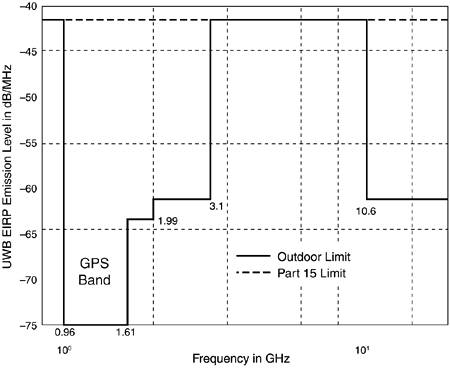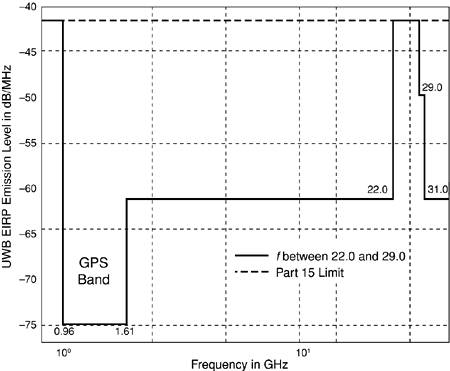Section 1.10. FCC Emission Limits
1.10. FCC Emission LimitsAs explained in Section 1.9, in order to protect existing radio services from UWB interference, the FCC has assigned conservative emission masks between 3.1 GHz and 10.6 GHz for commercial UWB devices. The maximum allowed power spectral density for these devicesthat is,41.3 dBm/MHz, or 75 nW/MHzplaces them at the same level as unintentional radiators (FCC Part 15 class) such as televisions and computer monitors. Based on the FCC regulations, UWB devices are classified into three major categories: communications, imaging, and vehicular radar. 1.10.1. Communications DevicesFor communications devices, the FCC has assigned different emission limits for indoor and outdoor UWB devices. The spectral mask for outdoor devices is 10 dB lower than that for indoor devices, between 1.61 GHz and 3.1 GHz, as shown in Figures 1-15 and 1-16, respectively. Figure 1-15. UWB emission limits for indoor communications systems. From E. Thomas, "Walk Don't Run: The First Step in Authorizing Ultra-Wideband Technology," IEEE Conference on Ultra Wideband Systems and Technologies (UWBST), May 2002. Copyright © 2002 IEEE. Used with permission.
Figure 1-16. UWB emission limits for outdoor handheld devices From E. Thomas, "Walk Don't Run: The First Step in Authorizing Ultra-Wideband Technology," IEEE Conference on Ultra Wideband Systems and Technologies (UWBST), May 2002. Copyright © 2002 IEEE. Used with permission.
According to FCC regulations, indoor UWB devices must consist of handheld equipment, and their activities should be restricted to peer-to-peer operations inside buildings. The FCC's rule dictates that no fixed infrastructure can be used for UWB communications in outdoor environments. Therefore, outdoor UWB communications are restricted to handheld devices that can send information only to their associated receivers. 1.10.2. Imaging DevicesFigure 1-17 shows the FCC emission limit for UWB-based through-wall imaging devices. The operation of these devices is constrained to law enforcement and rescue teams. Figure 1-17. UWB emission limits for through-wall imaging systems From E. Thomas, "Walk Don't Run: The First Step in Authorizing Ultra-Wideband Technology," IEEE Conference on Ultra Wideband Systems and Technologies (UWBST), May 2002. Copyright © 2002 IEEE. Used with permission.
1.10.3. Vehicular Radar SystemsVehicular radar systems are allowed to emit 41.3 dBm/MHz only in the 22 GHz to 29 GHz frequency range. The center frequency of their signal should be higher than 24.075 GHz. These radar devices are allowed to be mounted on terrestrial transportation vehicles and can be activated either while the vehicles are moving or while they are stationary. Figure 1-18 shows the FCC emission limit for UWB-based vehicular radar systems. Figure 1-18. Figure 1-18. UWB emission limits for vehicular radar systems From E. Thomas, "Walk Don't Run: The First Step in Authorizing Ultra-Wideband Technology," IEEE Conference on Ultra Wideband Systems and Technologies (UWBST), May 2002. Copyright © 2002 IEEE. Used with permission.
In general, the FCC ruling per application with Part 15 classification of 41.3 dBm for both outdoor and indoor operations can be summarized as shown in Table 1-3.
| ||||||||||||||||||||||||||||||||||||||||||||||||||
EAN: 2147483647
Pages: 93



